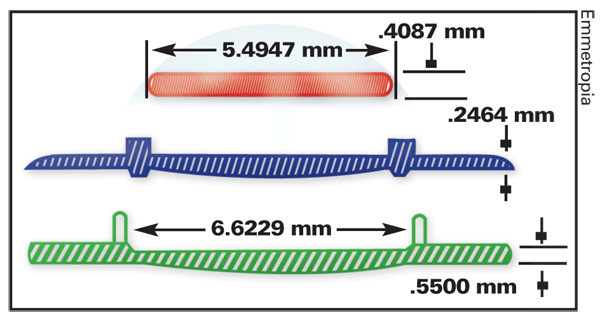For the surgeon who likes to keep his options open, there's an intraocular lens in trials in Europe that, in time, may allow the surgeon to implant a couple different optical technologies—then replace or upgrade them later if the need arises. This multipiece lens is called the PrecisionLens IOL. Here's an update on it.
Princeton, W. Va., surgeon Theodore Werblin is the owner of Emmetropia, the company behind the lens. He says the basic concept is a lens with three optical elements. "The posterior element is the base lens, and it's inserted in the capsular bag like a conventional lens," he explains. "It only differs from a conventional lens in that it has two posts, like bridges on the side of the optic, that allow optical elements to be placed on them. These elements, called the front lens assembly, are actually two optical pieces that are combined into one during the manufacturing process. Therefore, when the surgeon works with them, they will appear to be just one front element.

The front lens assembly sits in the sulcus but is attached to the base lens. The front lens is designed to be exchangeable, removable or adjustable without removing the whole lens from the bag, making an exchange fairly easy." The base element has a 6-mm optic; the front element is 5.5 mm. The front lens assembly is designed to have two separate optical properties: One is toric to correct either pre-existing or induced astigmatism and the other is spherical or multifocal to deal with presbyopia. "Postoperatively, if there's a problem with biometry, the way the eye heals, the capsule, et cetera, you can adjust the sphere and/or the cylinder and exchange or remove the multifocal aspect of the correction," says Dr. Werblin. He adds that if, in five or 10 years, there finally is a presbyopic lens that all surgeons like, the front lens assembly can be upgraded to that. Dr. Werblin says the multifocal component is currently just conceptual, and the final multifocal design that's used will depend on the lens manufacturer Emmetropia eventually works with. He says that replacing the front lens assembly differs from a normal lens exchange in that the latter can be difficult once the capsular bag has sealed to the back of an IOL, which isn't an issue if you're just removing the front assembly.
Ioannis Pallikaris, MD, at the Institute of Vision and Optics in the University of Crete, implanted the lens in four patients, and shares his results: "Four months after surgery, two of the patients underwent enhancement surgery with exchange of the front lens assembly in order to achieve emmetropia," he says. "At four months, the mean uncorrected acuity was 0.75 ±0.23 (a little less than 20/25 Snellen) while best-corrected acuity was 0.97 ±0.05 (about 20/20 Snellen). No patient lost any lines of vision. The PrecisionLens was centrally located in the capsule and there was good clearance between lens and iris. No complications oc-curred intra- or postoperatively."
Dr. Werblin hopes to begin U.S. trials for the lens in two years.




